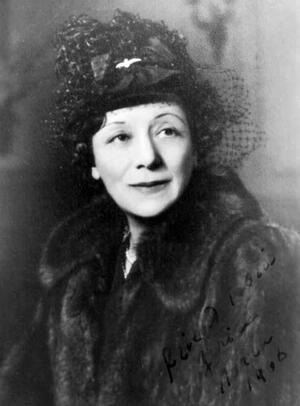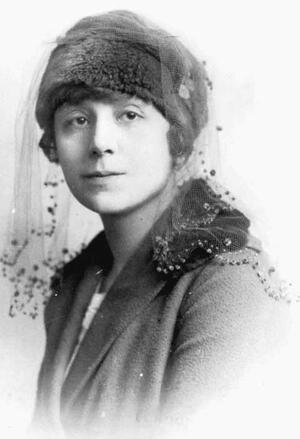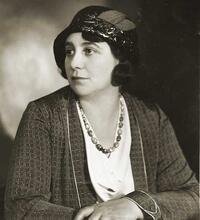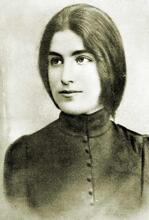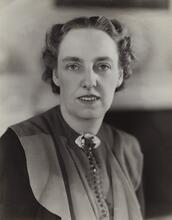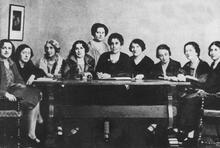Vera Weizmann
Growing up, Vera Weizmann did not learn Hebrew or Yiddish nor receive any religious or Zionist education. She was first introduced to Zionism in Geneva, where she studied medicine and met Chaim Weizmann. They married in 1906 and moved to Manchester, where in 1913 Vera was certified to practice medicine in Britain, becoming one of the first women physicians in Manchester. The family moved to London in 1916, where Vera joined forces with several other women to form a Zionist organization for women, the precursor to WIZO. For the rest of her life, Vera dedicated herself to the Zionist cause, assisting her husband, a key figure in the establishment of Israel and then the country’s first president, and continuing work in public service after his death.
Early Life and Education
Israel’s first “First Lady,” Vera Weizmann was born on November 27, 1881, in the Russian city of Rostov-on-Don to Isaiah and Feodosia Chatzman. Her father had been impressed in his youth into a 25-year term of military service as a cantonist and had fought in the Crimean War. His military service granted him the privilege of living beyond the Pale of Settlement. He married Feodosia, who had been raised in the city of Voronezh in Southwestern Russia, when she was fifteen years old—25 years younger than her new husband.
The daughter of a well-to-do wholesale clothing merchant, Vera grew up in a home with servants. Although the Jewish holidays were observed by the Chatzman family, only the two sons received a Jewish education, while the five daughters, including Vera, were not given any religious instruction and accordingly did not know a single word of Hebrew or Yiddish. Vera was totally ignorant of events in Palestine.
At the age of five Vera was sent to a French-speaking kindergarten to learn the language of high society and four years later she began to study at the Marinskaya Imperial Gymnasium. She studied music at the Rostov-on-Don conservatory before, at the age of fourteen, choosing medicine as her profession. Her second sister Sonia (Sophia), who also wanted to study medicine, was sent to Warsaw to study dentistry, since medicine was not considered to be a proper profession for a young woman. Except for her eldest sister, who married at the age of seventeen and did not further her studies, all the other Chatzman children received a higher education.
After completing her secondary-school education, Vera studied Latin with a private tutor in preparation for the entrance examination to medical school. When she turned eighteen, her parents consented to send her to Geneva to study medicine, where she subsisted on a monthly stipend from her eldest sister.
Marriage and Career in England
The Jewish student club in Geneva was host to manifold political activities, including the recruiting of Jewish students for their respective political movements by Russian Social Democrats, Bundists and Zionists. In 1900 Vera met Chaim Weizmann at the Zionist club. Although he was engaged to another woman at the time, Weizmann, who taught Vera German, nevertheless courted her and subsequently left his fiancée.
The couple were married in 1906 in the synagogue of Zoppot, Germany, six years after first meeting. Immediately after the wedding the couple went to Cologne for the annual conference of the Zionist Executive, after which they took a trip up the Rhine for their honeymoon before going to Manchester, where Weizmann was employed. Without friends and with no knowledge of English, Vera Weizmann felt isolated in Manchester; since most of Chaim’s friends spoke German or English, she was forced to learn both languages.
Her eldest son Benjamin (Benjy) was born in 1907. Three years later Vera Weizmann received British citizenship. As the family grew, she realized that they needed an extra source of income to maintain the family in comfortable circumstances; in 1913 she successfully passed the British medical certification examination, after having studied medicine for two years in Manchester in addition to her studies in Geneva. Vera Weizmann received a temporary posting as a physician in the Manchester slums, where she was in charge of seven clinics for pregnant women and infants to the age of one year. She was later awarded a permanent appointment as a physician in a public clinic for pregnant women. As one of the first women to be employed as a physician in Manchester during this period, her work consisted primarily of developing advanced methods for monitoring infant nutrition and weight. In connection with her work as a physician in Manchester, she met Charles Prestwich Scott, the editor of the Manchester Guardian, whom she introduced to Chaim; this acquaintanceship would later aid Chaim Weizmann to meet with Lloyd George and advance the acceptance of the Balfour Declaration.
In 1916 the Weizmann family moved to London, where their second son, Michael, was born in November of that year. Vera Weizmann began to keep a diary, became active as a political hostess, and as such helped to gain wider acceptance for the ideas of the Zionist movement.
The Need for Women’s Zionist Organizations
The following year the Zionist Federation of Britain, of which Chaim Weizmann was president, established a women’s committee to recruit additional women to the Zionist cause; Vera Weizmann was one of the committee’s six members. Dissatisfied with the limited role they were permitted to play in Zionist activity, the committee members decided to establish a separate Zionist women’s organization in Britain; three of the committee members—Vera Weizmann, Rebecca Sieff, and Romana Goodman—would become founding members of WIZO in 1920. A general assembly to found the women’s federation was held on January 12, 1919, with the agreement of the British Zionist Federation. Twelve organizations of Zionist women also joined, as well as several individuals such as Henrietta Irwell and Lady Beatrice Samuel (née Franklin, 1871–1959). Most of the women who joined either had experience in public activity, whether in local Zionist women’s organizations or in the general Jewish community, or had a general interest in political movements.
Vera Weizmann first visited Palestine in the fall of 1919, together with Sieff. Edith Eder joined them upon their arrival. All three were wives of leaders of the British Zionist movement, but they chose to visit Palestine without their husbands for the express purpose of examining the situation of women and children in Palestine. Acting as a representative delegation of the Ladies’ Committee of the Zionist Federation of Britain, they explored what could be done with the funds that they hoped to raise on behalf of women and children in Palestine. The delegation, which traveled throughout the country in October and November of that year, was horrified by the physical conditions in which the halutzim (pioneers) lived. The inhumane conditions suffered by the women halutzot made an especially deep impression on the members of the delegation, who decided that drastic action was needed.
Weizmann’s memoirs reveal that she adhered to the traditional conception of the roles of men and women in society—a position she expressed in her criticism of the goal of equality that the halutzot sought to attain. As a physician, she feared that women’s desire to share equally in hard physical labor not only reflected a negative spirit of denial of their femininity and the concomitant physical limitations, but also posed a tangible threat to their health. Notwithstanding these reservations, Weizmann was also aware of the lack of any professional and vocational courses of study that would prepare women to fulfill even the role for which women were traditionally designated. Weizmann reached the same conclusion as Sieff, that the halutzot had to be trained for what they regarded as “women’s work.”
Weizmann wrote in her autobiography: “[...] the whole situation worried us a great deal until it dawned on us that something drastic had to be done. On our return home, therefore, we decided to form a women’s organization, the purpose of which would be to fill the gaps and shortages which had faced us so disturbingly when we were in Palestine” (Weizmann 1967, 92). The women Zionist leaders, who championed traditional gender roles, were troubled by the total lack of concern for women’s needs (as they understood them): the training of women in the Jewish community in Palestine prior to the establishment of the State of Israel. "Old Yishuv" refers to the Jewish community prior to 1882; "New Yishuv" to that following 1882.Yishuv to fill their traditional household role in an educational framework that would utilize modern scientific and technological knowledge in the field of domestic economy. Coming to Palestine from a more developed country, they were concerned that tangible regard for women, the roles they fulfilled, and their special needs was totally absent from the activities of the Yishuv.
On July 11, 1920, at the first Zionist conference held after World War I, Olga Ginsburg initiated the founding of the Women’s International Zionist Organization (WIZO), together with representatives from organizations in Palestine, England, Germany, Poland, the Netherlands, Russia, and South Africa. It was decided to establish the central office in Palestine and to divide the work between the world center and London. In time, numerous other WIZO branches were set up in Jewish communities worldwide. Their main purpose was fundraising, whether by charging membership dues or by soliciting contributions to defined goals in Palestine. Rebecca Sieff was elected president of the new organization and Vera Weizmann, together with Henrietta Irwell, served as treasurer. In this role, Weizmann visited the Jewish communities throughout the world. She was a member of the WIZO Executive, which she chaired together with Rebecca Sieff for twenty years.
Travels to Palestine
Vera Weizmann visited Palestine for a second time in 1925, for the opening ceremonies of the Hebrew University in Jerusalem. The Daniel Sieff Research Institute was established in Rehovot by Rebecca and Israel Sieff in memory of their son, who had died under tragic circumstances. In April 1934 the Sieff Institute was inaugurated and for several months at the end of 1934 and the beginning of 1935 the Weizmanns lived in a small house that was rented from the poet Jessie Sampter before returning to London. Ten years later, upon Chaim Weizmann’s 70th birthday, the Institute was expanded, and its name was changed to the Weizmann Institute of Science.
A home was built especially for the Weizmanns in Rehovot, its construction spanning the years 1935–1937. The Weizmanns spent the winters of 1935, 1936 and 1937 in the town. In 1937, after living for only ten days in their new house, they were called back to London. They would not see their Rehovot home for another seven years, until 1944, when they were there for only a short time. They finally moved permanently to Rehovot only after the end of World War II. The house, planned by the architect Eric Mendelsohn, was used as a guest house by royalty, presidents of various countries, members of different Commissions of Inquiry, scientists, artists, and other prominent figures, as well as the general public.
In 1937 the Weizmann’s eldest son Benjy married Maidie Pomeranz and they had a son named David. Chaim and Vera’s second son Michael joined the Royal Air Force and served as a pilot during the war. In February 1940, on a flight against a German submarine in the Bay of Biscay, his plane dove into the water and Flight Lieutenant Michael Ozer Weizmann was declared missing in action. To cope with her pain, Vera Weizmann volunteered to work as a doctor in a Red Cross shelter in the London slums.
In 1944 the Weizmanns returned to Palestine to celebrate Chaim’s 70th birthday. Vera, who had not yet recovered from the death of her son, tried to bury herself in her work. She joined Chaim on his many visits throughout Palestine and contributed to his efforts to negotiate the founding of a Jewish state. They visited settlements and the ma’apilim (“illegal” immigrants) camp in Athlit, and Vera accompanied him on meetings with representatives of the Mandatory government.
In 1946 the couple once again returned to England, where they continued to engage in Zionist political activity before returning to Palestine in February 1947. Vera Weizmann hosted the members of UNSCOP at her Rehovot home for talks with the “ordinary citizen” Chaim Weizmann, and was also active in other ways on behalf of the “illegal” immigrants. In July 1947, when the Mandate government granted entry permits to Palestine for 500 children from among the detainees in the Cyprus detention camp (following the expulsion of the 4,500 immigrants on board the Exodus, who were sent back from Haifa to Germany), Vera Weizmann wrote a letter to the editor of the Palestine Post, in which she demanded that all 2,000 children be brought from Cyprus, and not only the 500 permitted by the British.
Israel’s First First Lady
When Chaim Weizmann was elected President by the Provisional Government after the establishment of the State of Israel, Vera wrote in her diary that she was now the “First Lady” of the State of Israel. She volunteered to help in the rehabilitation of those injured in the War of Independence. With the help of Dr. Chaim Sheba, she raised funds and mobilized support for the establishment of the Tel Hashomer Hospital, to which Dr. Sheba was appointed as director.
After her husband’s death in 1952, Vera Weizmann devoted even more of her time and energy to social work on behalf of Youth Aliyah, the rehabilitation of those disabled in the war, and Israel’s emergency medical and disaster service Magen David Adom, serving as its president. In 1954 she conducted a fund-raising campaign in South America for Israel Bonds and the Weizmann Institute. After visiting Argentina, Chile, and Brazil, she went with her secretary to Russia, which she had left 40 years earlier. She was also very active in arranging the Weizmann archives.
Vera Weizmann died on September 24, 1966, and was buried next to her husband in Rehovot. After her death, their home in Rehovot became a national site.
Herzog, Hanna, and Ofra Greenberg. A Voluntary Women’s Organization in a Society in the Making: WIZO’s Contribution to Israeli Society. Tel Aviv: Institute of Social Research, 1978.
Reinharz, Jehuda. Chaim Weizmann. Vol. 1: The Making of a Leader. New York: Oxford University Press, 1985.
Sieff, Israel. Memoirs. London: Weidenfeld and Nicolson, 1970.
Weizmann, Vera. The Impossible Takes Longer. London: H. Hamilton, 1967.

